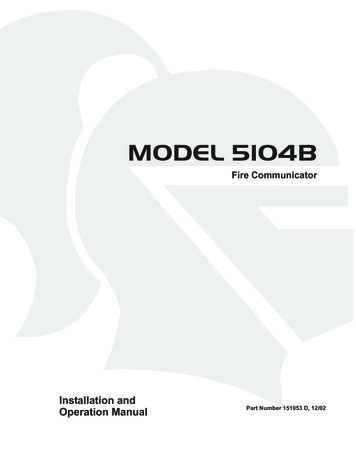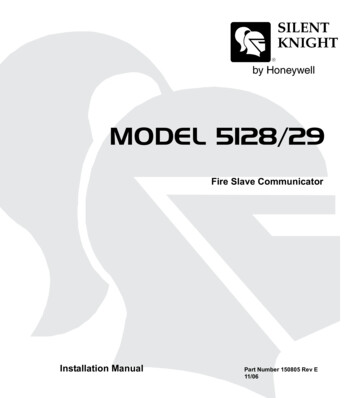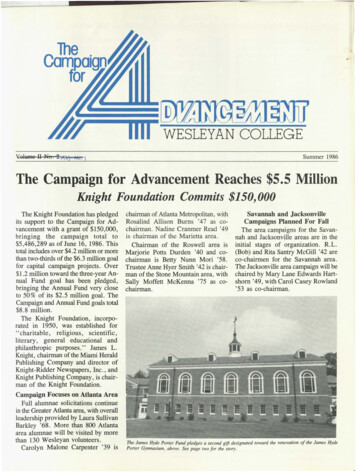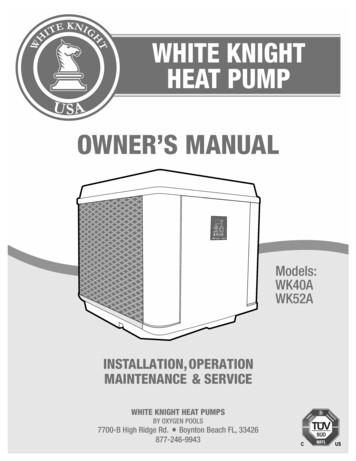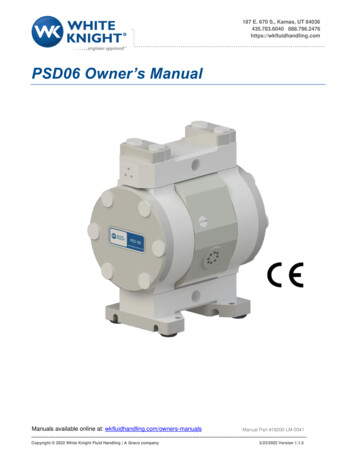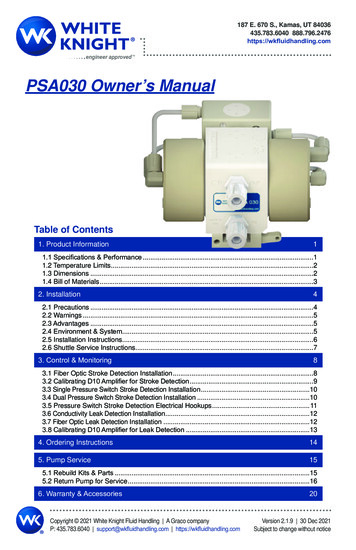
Transcription
MODEL 5104BFire CommunicatorInstallation/Operation ManualInstallation andOperations ManualDocument 151053-L803/20/2013Rev: F2151053-L8:F2 ECN: 13-0275
ContentsSection 1Introduction . 1-11.11.21.3Feature .1-1Accessory Devices .1-2About This Manual .1-21.3.1 How to Use This Manual .1-2Section 2Agency Requirements2.12.22.32.4. 2-1Telephone Requirements .2-1FCC Warning .2-2UL Requirements .2-2Canadian Department of Communications .2-2Section 3Installation. 3-13.13.23.33.4Electrical Specifications .3-1Environmental Specifications .3-1Wiring Specifications .3-2Panel Description .3-33.4.1 Terminal Description .3-43.4.2 LED Descriptions .3-53.4.2.1 Externally Visible LEDs (L3, L4, & L5) .3-53.4.2.2 Phone Line Fault Indicator LEDs (L6 &L7) .3-53.4.2.3 Overcurrent LED Indicators (L1 & L2) .3-63.4.3 Reset / Silence Switch .3-63.4.4 Cable Connectors (P1, P2, and P3) .3-73.4.5 On-board Piezo Sounder .3-73.5 Calculating Current Draw and Standby Battery .3-83.5.1 Worksheet Requirements .3-83.5.1.1 Maximum Battery Standby Load .3-83.5.2 Current Draw Worksheet .3-93.6 Mounting the 5104 Cabinet .3-103.6.1 Preventing Water Damage .3-103.7 Mounting the 5104 PC Board .3-113.8 AC Connection .3-113.8.1 Standard Transformer Connections .3-113.9 Battery Connection .3-123.10 Detector Installation .3-133.10.1 Class A (Style D) Zones .3-133.10.2 Class B (Style B) Zones .3-143.10.3 Four-Wire Smoke Detector Connection .3-153.11 Supplemental Notification Appliance Installation .3-163.11.1 Non-Supervised Notification Appliance Wiring .3-16151053i
3.11.2 Supervised Notification Appliance Wiring .3-183.12 Telephone Line Connections .3-193.13 Model 5230 Installation .3-203.13.1 Mounting the 5230 .3-20Section 4Add-on Fire Communicator ApplicationSection 55230 Operation5.15.2. 6-1UL 864 Programming Requirements .6-15230 Programming .6-16.2.1 Default User Codes .6-16.2.2 How to Enter and Exit Program Mode .6-26.2.3 How to Enter Program Mode .6-26.2.4 How to Exit Program Mode .6-26.2.5 Step Programming .6-26.2.6 Maneuvering in Program Mode .6-26.2.6.1 Entering Selected Values .6-26.2.6.2 Bypass a Step .6-46.2.6.3 Go to a Step .6-46.2.7 Programming Steps .6-5Section 7Reporting7.17.2. 5-15230 Display Messages .5-15230 Touchpad Functions .5-3Section 6Programming6.16.2. 4-1. 7-1Reporting Formats .7-1Reporting Codes .7-2Section 8Troubleshooting. 8-1Silent Knight Fire Product Warranty and Return PolicyManufacturer Warranties and Limitation of Liability151053ii
Installation ProcedureInstallation Precautions - Adherence to the following will aid in problem-freeinstallation with long-term reliability: WARNING - Several different sources of powercan be connected to the fire alarm control panel. Disconnect all sources of powerbefore servicing. Control unit and associated equipment may be damaged byremoving and/or inserting cards, modules, or interconnecting cables while the unit isenergized. Do not attempt to install, service, or operate this unit until manuals areread and understood. CAUTION - System Re-acceptance Test after SoftwareChanges: To ensure proper system operation, this product must be tested inaccordance with NFPA 72 after any programming operation or change in site-specificsoftware. Re-acceptance testing is required after any change, addition or deletion ofsystem components, or after any modification, repair or adjustment to systemhardware or wiring. All components, circuits, system operations, or software functionsknown to be affected by a change must be 100% tested. In addition, to ensure thatother operations are not inadvertently affected, at least 10% of initiating devices thatare not directly affected by the change, up to a maximum of 50 devices, must also betested and proper system operation verified. This system meets NFPA requirementsfor operation within the range of 0 C-49 C (32 F-120 F) or humidity within the rangeof 10%-93% at 30 C (86 F) noncondensing. However, the useful life of the system'sstandby batteries and the electronic components may be adversely affected byextreme temperature ranges and humidity. Therefore, it is recommended that thissystem and its peripherals be installed in an environment with a normal roomtemperature of 15-27º C/60-80º F. Verify that wire sizes are adequate for allinitiating and indicating device loops. Most devices cannot tolerate more than a 10%I.R. drop from the specified device voltage. Like all solid state electronic devices,this system may operate erratically or can be damaged when subjected to lightninginduced transients. Although no system is completely immune from lightningtransients and interference, proper grounding will reduce susceptibility. Overhead oroutside aerial wiring is not recommended, due to an increased susceptibility tonearby lightning strikes. Consult with the Technical Services Department if anyproblems are anticipated or encountered. Remove DC power prior to removing orinserting circuit boards. Failure to do so can damage circuits. Remove all electronicassemblies prior to any drilling, filing, reaming, or punching of the enclosure. Whenpossible, make all cable entries from the sides or rear. Before making modifications,verify that they will not interfere with battery, transformer, or printed circuit boardlocation. Do not tighten screw terminals more than 9 in-lbs. Over-tightening maydamage threads, resulting in reduced terminal contact pressure and difficulty withscrew terminal removal. Fire alarm control panels contain static-sensitivecomponents. Always ground yourself with a proper wrist strap before handling anycircuits so that static charges are removed from the body. Use static suppressivepackaging to protect electronic assemblies removed from the unit.Follow the instructions in the installation, operating, and programming manuals.
These instructions must be followed to avoid damage to the control panel andassociated equipment. FACP (Fire Alarm Control Panel) operation and reliabilitydepend upon proper installation.Equipment used in the system may not be technically compatible with the control. Itis essential to use only equipment listed for service with your control panel.Telephone lines needed to transmit alarm signals from a premise to a centralmonitoring station may be out of service or temporarily disabled. The most commoncause of fire alarm malfunctions, however, is inadequate maintenance. All devicesand system wiring should be tested and maintained by professional fire alarminstallers following written procedures supplied with each device. System inspectionand testing should be scheduled monthly or as required by national and/or local firecodes. Adequate written records of all inspections should be kept.
Section 1IntroductionThe Model 5104 is a low-cost fire communicator that meets the requirements forNFPA 72, UL 864, MEA, CSFM, and FM.1.1Feature Six supervised fire zones, consisting of one Class A (Style D) and five Class B(Style B) zones. Current limited loop power output for the Class B zone inputs. Ground fault detection. Built-in piezo sounder for trouble and supervisory conditions. Reset/Silence switch that performs the following:1 Silences troubles and alarms.2 Resets smoke detector power.3 Resets accessory power. Supervision of Reset/Silence switch. If the switch is depressed for 15 seconds orlonger, an audible trouble signal will occur. See section 3.4.3 24 hour battery backup from a 12 VDC, 7 Ah rechargeable battery. Separate battery charging circuit that maximizes battery life. Multiple reporting formats (SIA, SK 3/1, Sescoa 3/1, Contact ID, SK 4/2,Radionics BFSK). Programmable relay output provides additional annunciation for either alarm ordialer-failed condition. Three LEDs indicating AC power (green) status, Trouble Silenced (yellow), andDialer Failed (yellow). Four LEDs inside cabinet indicate short circuits and trouble conditions. Easy, English-language programming using the 5230 Remote Annunciator. Versatile two-number dialing feature for reporting to two different numbers. Programmable dialing format (rotary or Touch Tone). Two phone line monitoring and seizure circuits. Transient Voltage protection on all inputs (AC, phone lines, accessory zones). Automatic daily test. EEPROM memory storage of all programmed information.151053-L81-1
Model 5104B Fire Communicator Installation Manual1.2Accessory Devices Model 5230 Remote Annunciator (optional). Used for system control,programming and troubleshooting. Model 7860 modular cable with spade lugs for connection to Telco RJ31X plug(optional).1.3About This ManualThis manual is intended for those persons involved with the installation andmaintenance of the 5104 Fire Communicator. It is a comprehensive guide providingdetailed instructions, and should be kept for reference. As much as possible, we havetried to organize the manual chronologically by the tasks that need to be performed.Please let us know if the manual does not meet your needs in any way.1.3.1How to Use This ManualIn this manual, the following conventions are used:1-2 Pages of the manual are numbered by section. For example, a page numbered as5-1 is page 1 of Section 5. Text in this type face indicates a 5230 display message:System Normal.151053-L8
Section 2Agency RequirementsThis section list all the requirements for the 5104 by agency.Install and maintain in accordance with NFPA 72. Detector spacing shall be inaccordance to NFPA 72. End-of -line relays and resistors shall be placed within theelectrical box located and the end of the initiating circuit. Testing and maintenanceshould be performed according to NFPA 72.2.1Telephone RequirementsIf requested by telephone company the following information must be provided beforeconnecting this device to the phone lines:A.Manufacturer:Silent KnightB.Model Number:5104BC.FCC Registration Number:AC698R-17462-AL-ED.Type of jack (to be installed bythe telephone company):RJ31XRinger equivalence:0.1BThis device may not be directly connected to coin operated telephones or party lineservices.This device cannot be adjusted or repaired in the field. In case of trouble with device,notify the installing company or Silent Knight for an RA number and then return it to:Silent Knight12 Clintonville RoadNorthford, CT 06472-1610800-328-0103 or 203-484-7161If the Model 5104 causes harm to the telephone network, the telephone company willnotify the user in advance that temporary discontinuance of service may be required.If advanced notice is not practical the telephone company will notify the customer assoon as possible. You as the user have the right to file a complaint with the FederalCommunications Commission if you believe it is necessary.The telephone company may make changes in its facilities, equipment, operations, orprocedures that could affect the operation of the equipment. If this happens, thetelephone company will provide advance notice to allow you to make the necessarymodifications to maintain uninterrupted service.151053-L82-1
Model 5104B Fire Communicator Installation Manual2.2FCC WarningWarningThis device has been verified to comply with FCC Rules Part 15. Operation is subject to the followingconditions: (1) This device may not cause radio interference, and (2) This device must accept anyinterference received, including interference that may cause undesired operation.2.3UL RequirementsThe 5104 is UL listed as a Control Unit for use in Central Station Fire-ProtectiveSignaling Systems (UL864, NFPA 72). All UL installations must comply with thefollowing requirements:1. The 120 VAC wiring to the 5104 cabinet must be enclosed in conduit.2. Total standby current must not exceed 275 mA for central station use or 105 mAfor remote station use.3. Remote station installations must not attach any current drawing devices. Thisincludes 5230 Remote Annunciator.4. All electrical connections must comply with ratings shown in Section 3.Restricted Options: The loss of AC signal is defaulted to 3 hours however the system allows settingsfrom 0 - 30 hours. For UL certified installations this number must be set from 1 to3 hours. Call forwarding shall not be used.2.4Canadian Department of CommunicationsThe Canadian Department of Communications label identifies certified equipment.This certification means that the equipment meets certain telecommunicationsnetwork protective, operational and safety requirements. The Department does notguarantee the equipment will operate to the user’s satisfaction.Before installing this equipment, users should ensure that it is permissible for theequipment to be connected to the facilities of the local telecommunications company.In some cases, the company’s inside wiring associated with a single line individualservice may be extended by means of a certified connector assembly (telephoneextension cord). The customer should be aware that compliance with the aboveconditions may not prevent degradation of service in some situations.Repairs to certified equipment should be made by an authorized Canadianmaintenance facility designated by the supplier. Any repairs or alterations made bythe user to this equipment; or equipment malfunctions, may give thetelecommunication company cause to request the user to disconnect the equipment.Users should ensure for their own protection that the electrical ground–connectionsof the power utility, telephone lines and internal metallic water pipe system, if present,are connected together. This precaution may be particularly important in rural areas.CAUTION: Users should not attempt to make such connections themselves,but should contact the appropriate electric inspection authority, or electrician,as appropriate.2-2151053-L8
Section 3InstallationThis section contains information necessary to install the 5104 Fire Communicatorand accessories.3.1Electrical SpecificationsPrimary AC120 Vrms @ 60Hz, 374 maTotal DC load1.3 AmpAccessory Power12 VDC @ 750 mAPhone Line Voltage2.75 VDC min.Smoke Power12 VDC @ 750 mABattery Charging Voltage13.8 VDCMinimum Low Battery Detection10.2 VDCMinimum Low AC Detection102 Vrms @ 60 Hz, full loadAuxiliary Notification Appliance Circuit12 VDC @ 500 mA3.2Environmental SpecificationsIt is important to protect the 5104 panel from water. To prevent water damage, thefollowing precautions should be FOLLOWED when mounting the unit: Mount indoors in dry locations only Do not mount directly on exterior walls, especially masonry walls (condensation). Do not mount directly on exterior walls below grade (condensation). Protect from plumbing leaks. Protect from splash caused by sprinkler system inspection ports. Do not mount in areas with humidity-generating equipment (such as dryers,production machinery, etc.). Operating temperature range is 32 to 120 F (0 to 49 C). Indoor use only. 10% to 93% non-condensing humidity at 30 C (86 F). Non-corrosive environment.151053-L83-1
Model 5104B Fire Communicator Installation Manual3.3Wiring SpecificationsInduced noise (transfer of electrical energy from one wire to another) can interferewith telephone communication or even cause false alarms. To avoid induced noise,follow these guidelines: Isolate input wiring from high current output and power wiring. Do not pull onemulti-conductor cable for the entire panel. Instead, separate the wiring as follows:High VoltageAC PowerAudio input/outputPhone Line Circuits, Terminals 13-20Notification CircuitsTerminals 21-22Data Communication CircuitsTerminals 25-26 Do Not pull wires from different groups through the same conduit. If you must runthem together, do so for as short a distance as possible or use shielded cable.Connect the shield to earth ground at the panel only. High frequency noise, such as that produced by the inductive reactance of aspeaker or bell, can also be reduced by running the wire through ferrite shieldbeads or by wrapping it around a ferrite toroid. Route the wiring around the inside perimeter of the cabinet. It should not cross thecircuit board where it could induce noise into the sensitive microelectronics of pickup unwanted RF noise from the high speed circuits. See Figure 3-1 for anexample.Figure 3-1 Wire Routing Example3-2151053-L8
Installation3.4Panel DescriptionThis section describes the 5104 board components, including terminal strips, LEDs,Switches and cable connectors. See Figure 3-2.L3P2L4TerminalBlock 3L5L7L6L1L2TerminalBlock 1Reset/SilenceSwitchTerminalBlock 2TerminalBlock 4P1P3Figure 3-2 5104 Circuit Board151053-L83-3
Model 5104B Fire Communicator Installation Manual3.4.1Terminal DescriptionTable 3-1 lists the terminals by number and describes the terminals use.Table 3-1: Terminal Description by Terminal BlockTerminalBlock #1Terminal #1Loop A output (Class A Style D)2Loop B output3Loop B input4Loop A input2343-4Earth GroundImpedance(in Ohms)00005Input (Class B Style A)Power7(Power Limited)Zone 168ElectricalSpecificationDescriptionZone 20(Power Limited)Circuit GroundInput (Class B Style A)00Zone 309Power10Input (Class B Style A)11Power12Circuit Ground13Telco Ring14Telco Tip15House Ring16House Tip17Telco RingN/A18Telco TipN/A19House Ring20House Tip21Bell ( ) positive22Bell (-) negative23Ground24Accessory Power25Serial Data Out26Serial Data In27Input (Class B Style A)28Power29Input (Class B Style A)(Power Limited)00Zone 4(Power Limited)00N/AN/APhone Line1N/AN/APhone Line2N/AN/ANotificationCircuit(Power Limited)0005230(Power Limited)Annunciator(Power Limited)(Optional)000Zone 5Zone 5 & 6Zone 60(Power Limited)00151053-L8
Installation3.4.2LED DescriptionsThis section describes what each LED indicates. The 5104 has a total of seven LEDs,three are visible externally and four are visible only if the cabinet door is open. SeeSection 8 for additional information on LED operation.3.4.2.1 Externally Visible LEDs (L3, L4, & L5)This section describes the three LEDs (one green and two yellow) that are visibleexternally through the window on the 5104 cabinet door. Refer to Table 3-2 andFigure 3-2.Table 3-2: Externally Visible LEDsLED #NameColorDescriptionL3PowerGreenNormally ON unless the panel loses AC power or the panel isbeing reset.L4SilencedYellowNormally OFF unless a trouble or supervisory condition hasbeen silenced.L5DialerYellowNormally OFF unless there is a phone line or communicationproblem. See Section 3.4.2.2 for additional information.3.4.2.2 Phone Line Fault Indicator LEDs (L6 &L7)The 5104 has a built-in dual-phone line monitoring circuit. This circuit detects anyfault in the phone line by monitoring the loop current and DC voltage. If the phone linedrops to 1.8 VDC @ 5 mA or below for 40 to 90 seconds the on-board piezo and thecorresponding LED will turn ON. The control panel will then report the fault conditionto the central station on the other phone line. For example, if phone line one loosesphone line voltage, the on-board piezo and the L6 will turn on, then the control panelwill report the faulted line on phone line two. See Figure 3-2 for LED LocationsNote: To comply with NFPA 72 the model 5104 is equipped with phone line seizure. This means thatany time the control panel dialer needs to communicate with the central station, it will not be possible to use the telephones that are on the same line as the fire system. During communicationto the central station the phone lines will be seized for approximately one minute. However, underadverse telephone circuit conditions phone line seizure could last as long as 15 minutes.Table 3-3: Phone Line Fault Indicator LEDsLED #L6L7151053-L8NamePhone Line 1 FaultPhone Line 2 FaultColorDescriptionRedVisible only when the 5104 cabinet is open. If ON indicatesthat phone line 1 is faulted. A faulted condition is indicated ifthe phone line voltage drops below 1.8 VDC and the loopcurrent is less than 5 mA. Flashing indicates a communicationerror has occurred.RedVisible only when the 5104 cabinet is open. If ON indicatesthat phone line 2 is faulted. A faulted condition is indicated ifthe phone line voltage drops below 1.8 VDC and the loopcurrent is less than 5 mA. Flashing indicates a communicationerror has occurred.3-5
Model 5104B Fire Communicator Installation Manual3.4.2.3 Overcurrent LED Indicators (L1 & L2)The 5104 has two red LEDs which indicate if excessive current is being drawn by adevice connected to either the Accessory Power or Smoke Power circuits. Table 3-4lists the two overcurrent LEDs and gives a description of them. See Figure 3-2 forLED locations.Table 3-4: Overcurrent LED DescriptionLED #NameColorDescriptionL1Accessory PowerFaultRedIf a device connected to the accessory power circuit drawsmore than 750 mA the overcurrent poly fuse will open and L1will turn on.L2Smoke Power FaultRedIf a device connected to the smoke power circuit draws morethan 750 mA the overcurrent poly fuse will open and L2 willturn on.If either L1 or L2 turn on disconnect power immediately. Refer to Section 8 fortroubleshooting information.3.4.3Reset / Silence SwitchThe Reset/Silence switch has three functions: Silences audible trouble, or supervisory signals. A trouble or supervisory piezoannunciation will be silenced immediately when you press the switch.Note: If the switch is depressed for 15 seconds or longer an audible trouble signal will occur Resets smoke detector power. This function removes power from terminals 6, 9and 11.Note: To reset smoke detector power, depress the reset /trouble switch for a minimum of 1 second. Reset accessory powered devices. This function removes power from terminal 24.Note: To reset accessory powered devices depress the reset/silence switch for a minimum of 1 secondThe Reset/Silence switch is accessible inside the panel (DO NOT install the switchextender provided with the system) for UL certified installations.3-6151053-L8
Installation3.4.4Cable Connectors (P1, P2, and P3)There are two connectors on the 5104 (see Figure 3-2 for P1 and P2 locations). Thefunction of these connectors is as follows:ConnectorFunctionP1Connects the wires from the secondary winding of the AC transformerto the control panel. (See Section 8 Troubleshooting for additionalinformation.P2Used as a quick-connect for the 5230 Remote Annunciator to doprogramming or troubleshooting.P3Standby battery connector.3.4.5On-board Piezo SounderThe on-board piezo sounder gives an audible output for trouble, and supervisoryconditions. Troubles and supervisories can be silenced with the Reset/Silence switchimmediately.151053-L83-7
Model 5104B Fire Communicator Installation Manual3.5Calculating Current Draw and Standby BatteryThis section should be used to help you determine the current draw and standbybattery needs for your installation.3.5.1Worksheet RequirementsThe following steps must be taken when determining the 5104 current draw andstandby battery requirements.Fill in the Current Draw Worksheet (Table 3-6) in section 3.5.2.For the 5104, the worst case current draw is listed in Table 3-6 for the panel andaccessory devices.Follow these steps to properly fill in the Current Draw Worksheet.1. Fill in the number of devices used.2. Compute the current draw requirements for alarm and standby and record thisdata into line A.3. Add up the current draw for all the smoke detectors and record the totals in line B.4. Total all the notification appliance device loads and enter that number into line C.5. Make sure that the alarm current you calculated, including current for the panelitself, does not exceed 750 mA. This is the maximum current allowable.6. Complete the remaining instructions in Table 3-6 to determine battery sizerequirements.3.5.1.1 Maximum Ba
notify the installing company or Silent Knight for an RA number and then return it to: Silent Knight 12 Clintonville Road Northford, CT 06472-1610 800-328-0103 or 203-484-7161 If the Model 5104 causes harm to the telephone network , the telephone company will notify the user in advance that temporary discontinuance of service may be required.
